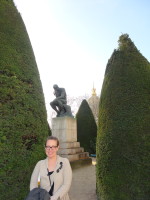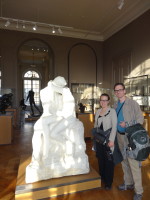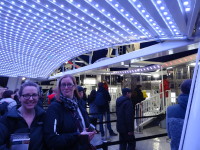 Today we started out a little later, heading out around 9:45, heading to Napoleon’s tomb and the Army Museum. It is yet another huge and impressive building, about the size of a city block, with a huge church as part of the complex (which includes a functional veterans’ hospital). The church was built by Louis XIV (of Versailles fame), but was co-opted to become the final resting place of Napoleon, along with some of his brothers and supporters (in more modest side-chapels, of course). Napoleon himself is inside multiple coffins, for reasons that escape me, but what you can actually see is a huge red stone tomb. You look down on the tomb from the second floor, where you enter, but you can go down to the tomb level, after you pass impressive stone statues depicting military and social governing. Napoleon is not wanting for good PR — his tomb is surrounded by friezes depicting him doing amazing and wonderful things, like dispensing justice, conquering other lands, making peace, and building things, all while dressed in the robes and laurel of a Roman emperor. Oddly, no mention of Waterloo anywhere.
Today we started out a little later, heading out around 9:45, heading to Napoleon’s tomb and the Army Museum. It is yet another huge and impressive building, about the size of a city block, with a huge church as part of the complex (which includes a functional veterans’ hospital). The church was built by Louis XIV (of Versailles fame), but was co-opted to become the final resting place of Napoleon, along with some of his brothers and supporters (in more modest side-chapels, of course). Napoleon himself is inside multiple coffins, for reasons that escape me, but what you can actually see is a huge red stone tomb. You look down on the tomb from the second floor, where you enter, but you can go down to the tomb level, after you pass impressive stone statues depicting military and social governing. Napoleon is not wanting for good PR — his tomb is surrounded by friezes depicting him doing amazing and wonderful things, like dispensing justice, conquering other lands, making peace, and building things, all while dressed in the robes and laurel of a Roman emperor. Oddly, no mention of Waterloo anywhere.
 We ducked into the complex’s chapel, which is large and simple, with what we think are flags flying from various military campaigns of France. There were staff people in the church setting up a nativity scene, which had a very French-looking Joseph.
We ducked into the complex’s chapel, which is large and simple, with what we think are flags flying from various military campaigns of France. There were staff people in the church setting up a nativity scene, which had a very French-looking Joseph.
We then proceeded upstairs to the second floor of the museum area; we went through the World War 1 display, which actually laid the foundations of the war by starting in the 1870s. I would have found the WW1 information interesting, but we did not have time to see it all; plus, most of it was written up in French.
We stopped in the World War 2 display, which was laid out on three floors, each of which showed a couple of years of the war, and focused on France’s role in the war, especially regarding the French resistance fighters and the free French army outside of France, with a strong section on the liberation of France, including D-Day. Many of the exhibits were in French, but the summaries of each section had a good English translation, and there were also supporting films and photos that did not need too much explaination. The museum is well done, and it is very understandable that it focuses so much on France. The parts of the exhibit that I understood about occupied France were interesting in that I did not know much about the resistance movement or about the tenuous “free” French state in the south of France.
 We headed over toward the Rodin Museum, where we were going to grab lunch at a cafe near the museum. We first had to make our way through the edge of a small protest group surrounded by automatic-weapon-wielding riot police. That does get your attention when you have to walk past that many guns. None of us had any idea of what was being protested, and after lunch, the plexiglass-wielding officer let us go by when we said we were headed to the Rodin Museum. Very odd, and a little unnerving.
We headed over toward the Rodin Museum, where we were going to grab lunch at a cafe near the museum. We first had to make our way through the edge of a small protest group surrounded by automatic-weapon-wielding riot police. That does get your attention when you have to walk past that many guns. None of us had any idea of what was being protested, and after lunch, the plexiglass-wielding officer let us go by when we said we were headed to the Rodin Museum. Very odd, and a little unnerving.
It was well worth it, though. I love sculpture, and Rodin is one of the best sculptors who ever lived. The museum exhibits show not only his finished work, both inside the museum and outside in the grounds and gardens, but also Rodin’s sketches and plaster work that led up to the final pieces. The museum had many of Rodin’s most famous works, including The Thinker, The Kiss, The Gates of Hell, statues of Balzac and Victor Hugo, and more. They are almost all laid out such that you can walk around them to see them from any angle. We even paid the four-euro fee to see the exhibit on the designing of The Gates of Hell, which included many sketches and mock-ups that evolved over ten years while Rodin planned the work. It was facsinating to see the evolution of his ideas over such a long time.
 We closed the museum out, leaving around 5:00. Ami was meeting an old friend at 7:30, so we had time to wander. We stumbled across an inviting street that was well-lit with Christmas decorations, and so we took the road. It had a pastry place, so I hopped in and we bought some baked goods. We were a few blocks from the Seine River, so I wanted to eat them there, where I could watch the boats go by. As we came across the river, Ami got excited at our proximity to the new Paris Ferris wheel, the Roue de Paris. She, and Meredith, wanted to go on it, so after we ate, we walked over and saw that there was almost no line. In we went. I am scared of heights, so it was a little rough for me, but I made it by closing my eyes for the highest parts. It also helped that while we were near the top of our second rotation (you go around twice), the light show on the Eiffel Tower went off, and that distracted me fairly well. It is pretty to see a city lit up at night, especially one with as many famous sights as Paris.
We closed the museum out, leaving around 5:00. Ami was meeting an old friend at 7:30, so we had time to wander. We stumbled across an inviting street that was well-lit with Christmas decorations, and so we took the road. It had a pastry place, so I hopped in and we bought some baked goods. We were a few blocks from the Seine River, so I wanted to eat them there, where I could watch the boats go by. As we came across the river, Ami got excited at our proximity to the new Paris Ferris wheel, the Roue de Paris. She, and Meredith, wanted to go on it, so after we ate, we walked over and saw that there was almost no line. In we went. I am scared of heights, so it was a little rough for me, but I made it by closing my eyes for the highest parts. It also helped that while we were near the top of our second rotation (you go around twice), the light show on the Eiffel Tower went off, and that distracted me fairly well. It is pretty to see a city lit up at night, especially one with as many famous sights as Paris.
We walked Ami over to her friend’s place, and then Mer and I went to dinner at a cafe for no other reason than it had the same name as a friend of ours – Mucha’s. After supper, we took the Metro home, where we got in at a fairly early 8:30.